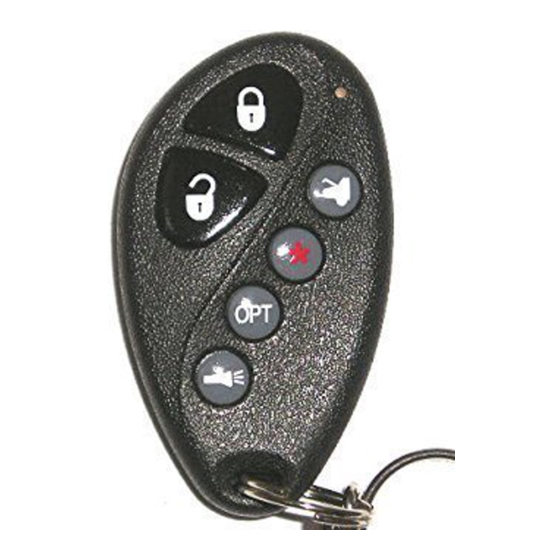Table of Contents
Advertisement
Quick Links
Remote Vehicle Control System
CA-135
Owner's Manual
Deluxe Vehicle Security System with
Two Way Confirming LED Remote
Control
IMPORTANT NOTE: The operation of the Security and Convenience System as described in this manual is
applicable to most vehicles. However, due to the configuration of some vehicles, some functions AND/OR SAFETY
PRECAUTIONS may not apply. Please see your installing dealer for more information.
Advertisement
Table of Contents

Summary of Contents for Code Alarm CA-135
- Page 1 Remote Vehicle Control System CA-135 Owner's Manual Deluxe Vehicle Security System with Two Way Confirming LED Remote Control IMPORTANT NOTE: The operation of the Security and Convenience System as described in this manual is applicable to most vehicles. However, due to the configuration of some vehicles, some functions AND/OR SAFETY...
-
Page 2: Table Of Contents
Table of Contents Using Your Remote Control ............3 Arming the security system Pre-arm mode Disarming the security system Disabling/Enabling confirmation chirps Attempted intrusion identification Using Your Remote Control, continued ........4 Two stage door unlock* Activating the trunk release feature* Turning on the vehicle’s headlights* Activating optional channel 2* Activating optional channel 3*... -
Page 3: Using Your Remote Control
Using Your Remote Control Arming the Security System To arm the system, exit the vehicle, close all doors, then press the LOCK icon button on the remote control. The system will sound twice and the parking lights will flash twice, indicating the system is armed. The doors will also lock at this time (if equipped and connected). -
Page 4: Using Your Remote Control, Continued
Using Your Remote Control, continued Two Stage Door Unlock If this feature is enabled on your system, pressing the UNLOCK icon button one time on the remote control will unlock only the driver’s door. Press disarm again within 15 seconds to unlock the remaining doors. -
Page 5: Using Your Remote Control, Continued
Using Your Remote Control, continued Using the Transmitter Flashlight Feature The (1) 6 button (non-confirming) remote control included with your system has a flashlight bulb built into the top of the remote control. Pressing and holding the LIGHT icon button on the remote control will activate the flashlight until the button is released. -
Page 6: Optional Songbird Feature
Optional Songbird Feature The optional songbird feature (Code Alarm part # SB1 and labor required) allows you to program songs and tones to your system (i.e. Setting a different tone for Lock activation and unlock activation). Turning Songbird On: Press and release the TRUNK icon button on the remote control, then press and hold the LOCK icon button on the remote control within 2 seconds. -
Page 7: Emergency Override Procedure
Emergency Override Procedure If your transmitter is lost or disabled, it will be necessary use the emergency override button to turn the security system off. There are two types of emergency override procedures. Check with your installing dealer to find out what has been activated on your system. Standard Emergency Override Procedure Enter the vehicle (the security system will trigger. -
Page 8: Code Systems, Inc. Limited Lifetime Warranty
Code Systems, Inc. Limited Lifetime Warranty A Code Systems Inc. (“CODE”) vehicle comfort, convenience and security system sold to a retail consumer purchaser by an authorized dealer of CODE and installed by an authorized dealer of CODE is warranted by CODE to the original retail consumer purchaser to be free from defects in workmanship and materials for the lifetime of the vehicle in which the system was originally installed. - Page 9 FCC COMPLIANCE This device complies with Part 15 of the FCC rules and with RSS-210 of Industry Canada. Operation is subject to the following two conditions: 1. This device may not cause harmful interference, and 2. This device must accept any interference received, including any interference that may cause undesired operation.













Need help?
Do you have a question about the CA-135 and is the answer not in the manual?
Questions and answers